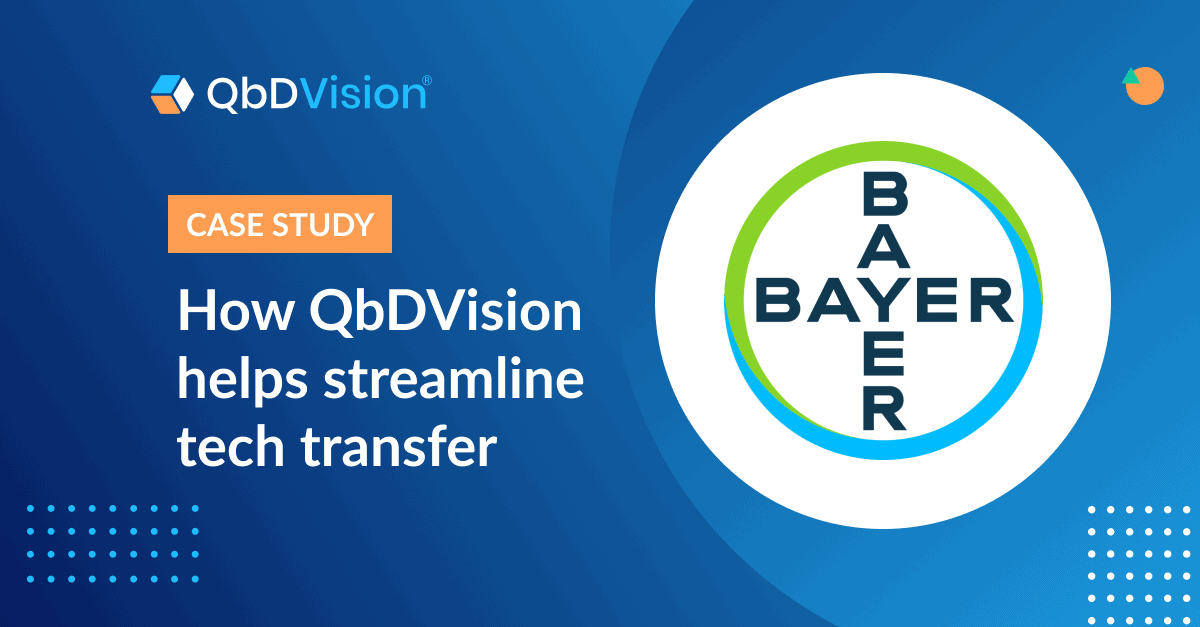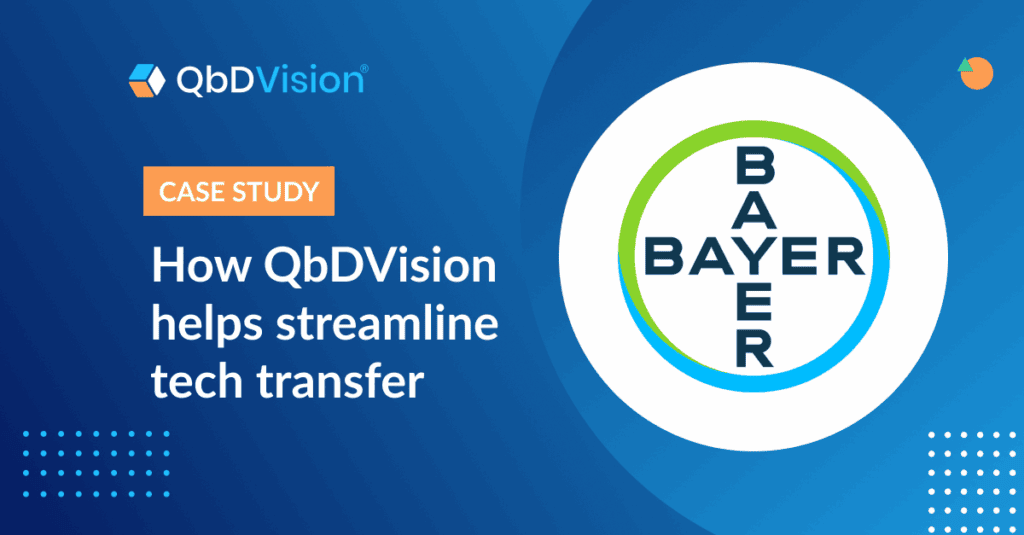Commitment to continuous evolution: Why Bayer partnered with QbDVision
Bayer had already built a legacy in drug development innovation within the life science industry by consistently pushing the boundaries of what’s possible. But while they were already known for fostering a culture geared towards continuous improvement across the organization, they were always on the lookout for ways to improve speed, collaboration, and cost-effectiveness.
By combining deep industry knowledge with forward-thinking solutions, Bayer’s CMC stakeholders had positioned themselves as innovation leaders by investing in QbDVision’s platform to digitalize product and process knowledge that had long been captured and managed within siloed, document-based workflows. Deploying QbDVision helped equip them to more efficiently share institutional knowledge across their product portfolio and streamline workflows like tech transfer.
Here’s how we helped Bayer deliver measurable results where they really mattered: in reducing all-too-familiar calendar overload in a key site’s tech transfer processes.
Cracking the tech transfer code
Tech transfers are famously inefficient, costly, and often result in frustrating delays that can push back key deadlines and delay time-to-market. While Bayer already had a robust and well-developed processes, they still shared common weaknesses seen across the industry: reliance on document-based workflows like Excel.
These tools, while useful to a point, struggle to manage unstructured data, lack the ability to link information for deeper insights, and fall short in supporting critical activities like risk assessments and gap analyses. Without a platform to connect data and focus efforts on impactful changes, teams often spent more time managing redundant records than advancing their processes efficiently.
As one of Bayer’s Lab Leads noted, “Initially our whole tech transfer workflow was Excel-based. There was a gap analysis XLS file for every unit operation and batch record type, with information about materials, and equipment.” This added substantial redundancy to initiating new projects.
Although their CMC contributors and reviewers had an aligned process for transfer projects and a common framework for executing them, they still faced challenges like duplicated work, multiple variations of key CMC deliverables, and time-consuming efforts to remediate the inconsistencies. Their standard method for addressing these problems—a long cycle of cross-functional meetings—added many more hours to the process.
To tackle that challenge, their process development team turned to a platform purpose-built to manage CMC data across the drug product life cycle. Together, we made dramatic progress in streamlining their internal tech transfer process—to the tune of up to 80% reduction in per-transfer cost.
Let’s look closer at how.
Duplication, delays, and calendar crises: A closer look at the tech transfer challenge
Our first step: Working with a site team to map their existing tech transfer processes and uncover the biggest areas for improvement.
We quickly identified a familiar operative problem: siloed, decentralized processes for producing, reviewing, and exchanging CMC data. Knowledge and lessons learned from completed tech transfers were not shared across the organization or were not sufficiently accessible for future projects.
This siloed approach made it very difficult to understand processes. XLS files were unstructured, with no distinction between parameters, materials, process components, steps, or other process elements.
This all-too-common challenge had several causes and complicating factors that we’ve helped many drug developers address:
- No single source of truth across portfolio: With no shared knowledge management system, both CMC contributors and reviewers managed their data and knowledge separately, through offline documents, with little insight into each other’s resources, efforts, and progress.
- Lack of common taxonomy: With no way to harmonize their efforts or see what other sites are doing, individual sites often created their own lexicons for those processes and deliverables. Key parameters, datapoints, and characteristics frequently had multiple different names across sites, often leading to misunderstandings and more meetings.
- Lack of shared visibility: Because contributing teams worked offline from each other, duplicated outputs were common. And not surprisingly, those deliverables often came with substantial variations of their own that need to be reconciled before moving forward.
- Meeting-intensive alignment processes: Most of that reconciliation happened in long strings of multidisciplinary meetings between platform and site teams.
With QbDVision’s structured framework, Bayer linked parameters, components, and steps across their platform processes. It created a single source of truth that enabled project teams to share visibility into their workflows, standardize taxonomies across units, and collaborate seamlessly.
For this particular site, these issues had produced a suboptimal tech transfer process with a major margin for error. Functional teams all worked off a shared offline document, before giving it to Quality and Regulatory, who sent their separate edits to each team for updates and finalization. Only then would sites compare, reconcile, and harmonize their work in a shared deliverable—one that then needed to be re-reviewed by Quality and Regulatory before finalization.
And throughout that process: Multiple cross-functional meetings every week. “All changes from non-GMP to GMP were discussed all over again in every new project, even though many of them had already been discussed multiple times in previous tech transfers,” the Lab Lead noted. “Processing that information took 3-6 people meeting 3 times a week for up to 6 weeks at a time.”
With no shared knowledge management framework—one that made it easy to sift new, approved, and in-review changes—the site’s typical tech transfer had a challenging critical path. But luckily for their process development team, the solution was simple: a digital platform that makes capturing, sharing, and comparing data as easy as a click.
The solution: Centralized, structured CMC data management
Limited cross-functional visibility, duplicated efforts, and variable outputs, all resolved through endless meetings: it’s an all-too-familiar scenario and a defeating cycle, one that keeps new medications out of patients’ hands.
For this site, addressing this industry-wide issue started with deploying QbDVision: a centralized CMC data management platform that enables organizations to move beyond fragmented, redundant processes and towards a more collaborative transfer.
To simplify their tech transfer process and eliminate redundancies, we knew we needed to deploy our platform in a way that enhanced collaboration and decision support for all the teams involved. To do that, we focused on using QbDVision to achieve several key operational goals:
- Centralizing knowledge management and exchange framework: On Day 1, our platform provided an essential resource that the site’s process developers had been lacking: a unified framework for managing, sharing, and collaborating on CMC data with their reviewers.
- Streamlining collaboration: With our platform in place, contributors and reviewers finally had a single reference point for all the CMC deliverables they needed to exchange, compare, and review. QbDVision made accessing that data as simple as logging in: No more document gathering, manual handoffs, or time-consuming narrative reviews.
- Providing mutual visibility: With a clear view of an entire program’s CMC knowledge, all the relevant CMC contributors could easily tell which steps had already been taken and which still needed to be completed. Time spent duplicating efforts decreased dramatically, as teams began focusing only on additive tasks and necessary deliverables.
- Normalizing nomenclature: With our platform’s systematized taxonomy and regulatory-aligned ontologies, our customer’s CMC contributors could finally start speaking the same language about their deliverables. Exchanges that once took months of manual review and translation could now be handled in minutes.
- Reducing meeting loads: Now that teams at Bayer could easily reference the same shared information in QbDVision, many time-consuming review and harmonization meetings became obsolete. Once our platform deployed, users instantly saved hours they could use to move their projects forward.
With those foundational changes in place, Bayer was able to dramatically overhaul its internal tech transfers and establish a more time- and cost-efficient process.
Here’s what that looked like for this particular site and their reviewer stakeholders.
Log in, compare, complete: What QbDVision-powered data exchange can look like
Before long, our customer’s site team had unlocked one of the biggest benefits of Digital CMC: Less time spent gathering, compiling, and reviewing data, more time spent generating insights, discoveries, and innovations.
One Lab Lead recalled, once their units had consolidated their data in QbDVision, “It truly became our single source of truth. The number of process records dropped drastically. Only records different from the platform had to be discussed by each team.”
In fact, with QbDVision’s platform, the endless back-and-forth exchanges that hampered their tech transfer were replaced with a simple, streamlined 5-step process:
- Step 1, Process Definition: The process development team at the sending site establishes the master manufacturing process in QbDVision.
- Step 2, Receiving Site Input: Receiving sites then add their own localized process versions to QbDVision, for comparison with the sending site’s master process.
- Step 3, Shared Site Review: Sending and receiving teams can then see a unified view of the same sending- and receiving-site processes, identify any deltas, and easily focus on just the changes that need to be made.
- Step 4, Site Alignment: Sending and receiving teams can then easily address any modifications or accommodations needed to harmonize platform- and site-level processes.
- Step 5, Quality & Regulatory Approval: Once sending and receiving sites are aligned, Quality and Regulatory reviewers simply log in one more time to approve the results.
Crucially, this process allowed teams to proactively identify process discrepancies and address them upfront. For this site team and their colleagues, this was a welcome departure from their legacy tech transfer process—which often led to surprise discrepancies, confusing taxonomy variances, and other issues that frequently derailed larger transfer initiatives.
By the numbers: Bayer’s time and cost savings
While QbDVision’s platform clearly helped streamline site-to-site processing for this particular site, the business-level results were equally impressive. The transformative impact on Bayer’s transfer performance included significant cost and time savings:
- 2-6 week reduction in gap/risk assessment from non-GMP to GMP facility.
- Up to 80% reduction in transfer-related meeting hours.
- 50% reduction in overall level of effort for an average site-to-site
A significant aspect of this digital transformation was establishing a manufacturing process platform within QbDVision, which enabled Bayer to centralize and standardize process knowledge across their portfolio. While knowledge sharing within individual projects was already a strength, QbDVision elevated this by creating a unified framework that facilitated knowledge transfer across functions and between projects, driving greater efficiency and consistency throughout their site’s tech transfer workflows
Above all, this QbDVision deployment clearly showed what’s possible when process meets purpose.
By adopting a centralized, structured approach to CMC data management, this site not only streamlined its tech transfer workflows but achieved significant cost and time savings that set a new standard for operational excellence. With significant reductions in per-transfer costs and dramatic decreases in meeting hours and review timelines, their team demonstrated how leveraging digital solutions can transform traditional processes.
This success also highlighted Bayer’s continuous commitment to improvement and its role as a leader in embracing technology to deliver better, faster results in drug development. As they continue to advance their organizational plan, we’re excited to see QbDVision playing an active role in streamlining their products and processes.
GET IN TOUCH
Ready to rethink your tech transfer processes?
Reach out to learn how we’ve delivered dial-moving efficiencies for top-tier drug developers customers like Bayer.


























































